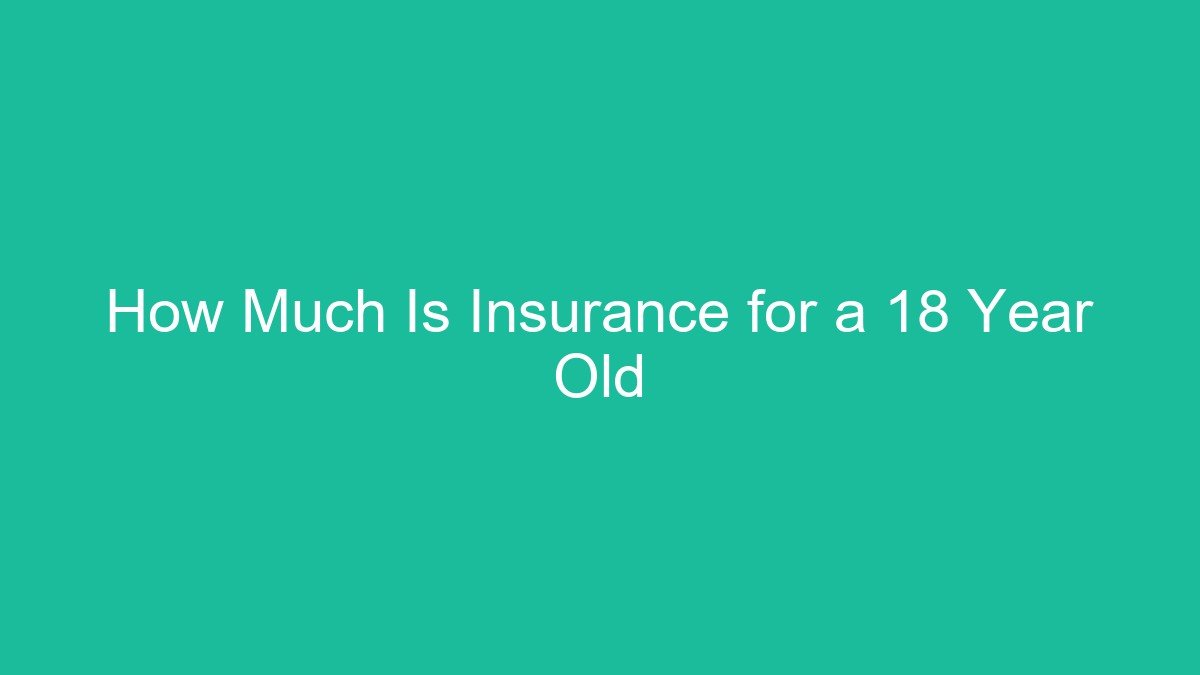
Contents
- How Much Is Car Insurance for an 18-Year-Old? Your Ultimate Guide to Understanding Costs and Saving Money
- 🛒 Recommended Product
- Why is Car Insurance So Expensive for 18-Year-Olds?
- So, What’s the Average Cost?
- Key Factors That Affect Your Premium
- Step-by-Step Guide to Getting Insurance at 18
- 🛒 Recommended Product
- Top Tips to Save Money on Car Insurance for 18-Year-Olds
- Common Mistakes to Avoid
- Conclusion
- 🛒 Recommended Product
- FAQ
How Much Is Car Insurance for an 18-Year-Old? Your Ultimate Guide to Understanding Costs and Saving Money
Turning 18 is a huge milestone! You’re gaining more independence, maybe heading off to college, or starting your first full-time job. And for many, it also means the exciting prospect of driving your own car. But before you hit the open road, there’s a crucial step: getting car insurance.
The big question on every young driver’s mind (and often their parents’ too!) is: “How much is car insurance for an 18-year-old?”
Let’s be upfront: Car insurance for an 18-year-old is typically more expensive than for older, more experienced drivers. But don’t despair! While it might seem daunting, understanding why it’s expensive and what you can do to lower the cost can make all the difference. This detailed guide will walk you through everything you need to know.
🛒 Recommended Product
Why is Car Insurance So Expensive for 18-Year-Olds?
Insurance companies are all about assessing risk. Statistically, new and inexperienced drivers, particularly those under 25, pose a higher risk of getting into accidents. This isn’t to say you’re a bad driver, but the data shows:
- Lack of Experience: Less time behind the wheel means less exposure to various driving conditions and emergencies.
- Higher Accident Rates: Studies consistently show that young drivers, especially males, have higher accident rates compared to older drivers.
- More Severe Accidents: Accidents involving young drivers sometimes result in more severe injuries and property damage.
- Distraction Risk: Younger drivers can be more prone to distractions like cell phones and friends in the car.
Because 18-year-olds fall into this high-risk category, insurance companies charge higher premiums to offset the potential cost of claims.
So, What’s the Average Cost?
Providing an exact average cost for an 18-year-old is challenging because there are so many variables (which we’ll cover next!). However, you can generally expect to pay anywhere from $2,000 to $7,000+ per year for an individual policy.
- Keep in mind: This is a broad estimate. Your actual premium could be higher or lower depending on your specific situation.
- The absolute best way to get an accurate estimate is to get personalized quotes.
Key Factors That Affect Your Premium
Understanding these factors will help you make informed decisions and better predict your insurance costs:
- Your Driving Record: This is HUGE. A clean driving record with no tickets or accidents is your best friend. Any moving violations (speeding, reckless driving) or at-fault accidents will significantly increase your rates.
- Vehicle Type:
- Expensive, high-performance, or luxury cars cost more to insure because they’re more expensive to repair or replace.
- Older, safer, and less powerful sedans or SUVs are generally cheaper to insure.
- Cars with advanced safety features might qualify for discounts.
- Your Location:
- Urban areas typically have higher rates due to more traffic, higher accident rates, and increased risk of theft/vandalism.
- Rural areas generally have lower rates.
- Even within a city, specific ZIP codes with higher crime rates can lead to higher premiums.
- Coverage Levels and Deductibles:
- Minimum state liability coverage will be the cheapest but offers the least protection.
- Full coverage (including collision and comprehensive) offers more protection but costs significantly more.
- Your deductible (the amount you pay out-of-pocket before insurance kicks in) also plays a role. A higher deductible typically means a lower premium, but you’ll pay more upfront if you have a claim.
- How You’re Insured:
- Being added to a parent’s existing policy is almost always the cheapest option for an 18-year-old. Your parents’ good driving record and established history often help keep the rates lower for you.
- Getting your own individual policy will be much more expensive due to your lack of personal driving history and higher risk profile.
- Your Grades (Yes, Really!): Many insurers offer “good student discounts” for young drivers who maintain a certain GPA (often B average or 3.0). This shows responsibility!
- Usage: How much you drive and for what purpose (commuting, pleasure, business) can impact rates.
- Credit Score (in most states): While not directly tied to driving, insurance companies often use a credit-based insurance score to assess risk. A good credit history can lead to lower premiums.
- Gender (in some states): In states where it’s permitted, young males often pay more than young females due to statistical differences in accident rates. However, many states have banned this practice.
Step-by-Step Guide to Getting Insurance at 18
Getting your first car insurance policy (or being added to an existing one) might seem complicated, but breaking it down makes it simple.
Step 1: Gather All Necessary Information
Before you even start looking for quotes, have these details ready:
- Your Driver’s License Number: And the date you got your license.
- Vehicle Information: Make, model, year, VIN (Vehicle Identification Number), current mileage, and primary parking location.
- Academic Information: If you’re a student, have proof of your GPA (e.g., transcript) for potential good student discounts.
- Driving History: Be prepared to honestly report any tickets, accidents, or previous claims.
- Financial Information: If you’re getting your own policy, your payment preferences (credit card, bank account) and potentially your credit score may be relevant.
Step 2: Understand Different Coverage Types
Knowing what you’re buying is crucial.
🛒 Recommended Product
- Liability Coverage: This is mandatory in almost every state. It covers damages (bodily injury and property damage) you cause to other people and their property if you’re at fault in an accident. It does NOT cover your own injuries or vehicle damage.
- Collision Coverage: This pays for damages to your own car if you hit another car, an object, or roll over, regardless of who is at fault.
- Comprehensive Coverage: This covers damages to your car from non-collision events like theft, vandalism, fire, hail, falling objects, or hitting an animal.
- Personal Injury Protection (PIP) or Medical Payments (MedPay): Covers medical expenses for you and your passengers after an accident, regardless of fault (required in some states).
- Uninsured/Underinsured Motorist (UM/UIM) Coverage: Protects you if you’re hit by a driver who has no insurance or not enough insurance to cover your damages.
Step 3: Decide on Your Coverage Needs
This is where you balance protection with cost.
- If you have a car loan or lease, full coverage (liability, collision, and comprehensive) will almost certainly be required.
- If you own an older, low-value car outright, you might consider only liability insurance to save money. However, understand the risk that you’ll have to pay for all your own repairs or replacement if something happens.
- Consider your financial situation. Could you afford to replace your car out-of-pocket? If not, more comprehensive coverage might be worth the cost.
Step 4: Shop Around for Quotes
This is perhaps the most important step for finding affordable insurance.
- Don’t settle for the first quote you get!
- Contact multiple insurance providers directly (online, phone, or local agents). Each company uses its own rating system, so prices can vary significantly for the exact same coverage.
- Get quotes from at least 3-5 different insurers.
- If your parents have an existing policy, definitely ask them to get a quote to add you to their policy first. This is often the cheapest route.
Step 5: Compare Quotes Carefully
When you receive quotes, don’t just look at the bottom line premium.
- Ensure you’re comparing apples to apples. Are all quotes for the exact same types and amounts of coverage (e.g., $100k/$300k liability, $500 deductible for collision/comprehensive)?
- Look at the details of each policy, including deductibles and any included perks.
- Ask about potential discounts you might be eligible for.
Step 6: Choose Your Policy and Purchase
Once you’ve compared and found the best option for your needs and budget:
- Confirm your chosen coverage with the insurer.
- Understand the payment terms. (Monthly, semi-annually, annually). Sometimes paying annually can offer a small discount.
- Provide accurate payment information.
- Ensure the policy start date aligns with when you need coverage. Never drive without active insurance!
- You’ll receive proof of insurance (ID cards and policy documents) once your purchase is complete.
Top Tips to Save Money on Car Insurance for 18-Year-Olds
Even with the higher initial costs, there are many ways to reduce your premium:
- Stay on a Parent’s Policy (If Possible): This is by far the most effective way for an 18-year-old to save money. If you live at home and your parents are willing, being listed as a driver on their existing multi-car, multi-policy discount-laden plan will almost always be cheaper than your own individual policy.
- Choose the Right Vehicle:
- Opt for a safe, reliable, and moderately priced car with good safety ratings.
- Avoid sports cars, high-performance vehicles, or cars known for high theft rates.
- Cars with modern safety features like anti-lock brakes, airbags, and anti-theft devices can qualify for discounts.
- Maintain a Clean Driving Record: This cannot be stressed enough. Avoiding tickets and accidents is the absolute best long-term strategy for keeping your rates down. Every clean year behind the wheel will help lower your premiums as you gain experience.
- Look for Discounts: Always ask your insurance provider about available discounts. Common ones include:
- Good Student Discount: For maintaining a B average or better.
- Driver’s Education/Defensive Driving Course Discount: Completing an approved course can show responsibility.
- Telematics/Usage-Based Insurance Programs: These involve installing a device in your car or using a smartphone app to track your driving habits (speed, braking, mileage). Good driving habits can lead to significant savings.
- Multi-Car Discount: If there are multiple vehicles on the policy.
- Multi-Policy/Bundling Discount: If you have other insurance policies with the same company (e.g., home or renter’s insurance).
- Student Away at School Discount: If you attend college more than a certain distance from home and don’t take your car with you.
- Increase Your Deductible: If you have collision and comprehensive coverage, raising your deductible from, say, $250 to $500 or $1,000 will lower your premium. Just make sure you have enough in savings to cover that deductible if you need to file a claim.
- Consider Dropping Certain Coverages on Older Cars: If your car is older and has a low market value, the cost of collision and comprehensive coverage might outweigh the potential payout if it’s totaled. This is a risky move, so weigh it carefully.
- Pay Your Premium Annually or Semi-Annually: Many insurers offer a small discount if you pay your entire premium upfront rather than in monthly installments.
- Improve Your Credit Score (if getting your own policy): A good credit score often correlates with lower insurance rates.
Common Mistakes to Avoid
Don’t let these pitfalls cost you more money or leave you inadequately protected:
- Not Shopping Around Enough: This is the #1 mistake. Sticking with the first quote you get means you’re almost certainly overpaying.
- Underinsuring Yourself: Choosing only the minimum liability coverage might seem cheap, but if you cause a serious accident, you could be on the hook for hundreds of thousands of dollars out-of-pocket if your coverage limit isn’t enough. Financial ruin for a young adult is a very real possibility with insufficient coverage.
- Lying on Your Application: Never misrepresent your driving record, mileage, or where your car is garaged. If the insurance company discovers you lied, they can deny your claims, cancel your policy, and even pursue legal action.
- Ignoring Discounts: Always ask what discounts are available. You might qualify for several that you didn’t even know about.
- Choosing the Cheapest Policy Without Understanding Coverage: The cheapest policy isn’t always the best. Make sure the coverage limits and types meet your needs and offer adequate protection.
- Not Reviewing Your Policy Annually: Life changes. Your car’s value decreases, you might move, or your driving habits could change. Review your policy at renewal time to ensure it still fits your situation and to check for better rates.
- Driving Without Insurance: This is illegal in almost every state and can lead to severe penalties, including fines, license suspension, and even jail time.
Conclusion
While the cost of car insurance for an 18-year-old can be a significant expense, it’s an unavoidable and essential investment in your financial protection and peace of mind. By understanding the factors that influence your premium, being proactive in seeking discounts, and making smart choices about your vehicle and coverage, you can absolutely find an affordable policy that meets your needs.
🛒 Recommended Product
Start by getting multiple quotes today, and remember: safe driving habits are your best long-term strategy for lower insurance costs!
FAQ
Q. Why is car insurance so expensive for an 18-year-old?
A. Insurance companies classify 18-year-olds as high-risk drivers due to their limited driving experience and a higher statistical likelihood of being involved in accidents, which are often more severe. This increased risk translates directly into higher premiums to offset potential payout costs.
Q. What factors specifically influence the cost of car insurance for an 18-year-old?
A. Several factors come into play: the driver’s gender (in states where allowed), academic performance (good student discounts), type of vehicle (newer, more powerful, or luxury cars are more expensive to insure), geographic location (urban areas typically cost more), the chosen coverage limits and deductibles, and any prior driving history (tickets or accidents).
Q. Is it cheaper for an 18-year-old to be on a parent’s policy or get their own?
A. In almost all cases, it is significantly cheaper for an 18-year-old to remain on a parent’s existing car insurance policy. This is because they benefit from the parent’s longer driving history, higher credit score (if applicable), multi-car discounts, and the overall pooling of risk, which dilutes the perceived high risk of the young driver.
Q. What types of car insurance coverage are essential for an 18-year-old?
A. At a minimum, liability coverage (bodily injury and property damage) is legally required in most states to cover damages the 18-year-old might cause to others. It’s highly recommended to also consider collision coverage (for damage to their own vehicle in an accident) and comprehensive coverage (for non-collision events like theft, vandalism, or natural disasters), especially if the car is new, valuable, or financed.
Q. What discounts are available to help lower insurance costs for an 18-year-old?
A. Many insurers offer discounts such as a “Good Student Discount” for maintaining a B average or higher, completing a state-approved defensive driving course, and potentially telematics programs that monitor driving habits (like speed and braking) in exchange for lower rates. Driving an older, safer, or less powerful vehicle can also help.
Q. How much does car insurance typically cost for an 18-year-old?
A. The cost varies widely, but an 18-year-old can expect to pay anywhere from $200 to $500 or more per month, especially if they are on their own policy. As part of a parent’s policy, the increase will be less dramatic but still significant, often adding $100-$300+ per month to the family’s premium, depending on all the factors mentioned above.
Q. How does getting a traffic ticket or having an accident impact an 18-year-old’s insurance rates?
A. Even a minor traffic ticket or a small at-fault accident can have a substantial and long-lasting negative impact on an 18-year-old’s insurance rates. Premiums can increase significantly, sometimes by 20-50% or more, and these surcharges can remain on their record for three to five years, making insurance even more expensive during a period when it’s already costly.
Related Articles
How Much Does a Tesla Cybertruck Cost
How Much Does a Tesla Cybertruck Cost? Your Ultimate Guide to Pricing & Purchase The Tesla Cybertruck has captured imaginations with its futuristi…
How Much Is a Tesla
How Much Is a Tesla? Unpacking the Cost of Your Dream EV Dreaming of driving a Tesla? You’re not alone! These innovative electric vehicles have …
Affiliate Disclosure: As an Amazon Associate, I earn from qualifying purchases made through links on this site.















